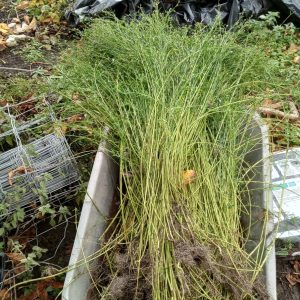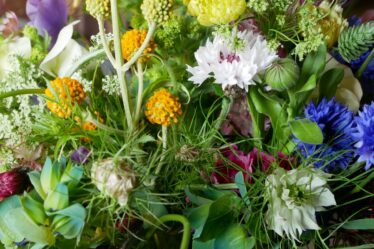I really like the idea of using a ribbon that is plant based to go around my flowers
I’ve made the decision to stop using silk ribbon to tie around wedding bouquets. I’m going to offer linen instead. I’ve never felt entirely comfortable using silk, as I’m a vegetarian who doesn’t wear leather. More about how silk is made below, but in the meantime, let me explain why linen is a wonderful choice.
Linen is a beautiful fabric that improves with age and wear – it softens up over time (and this process can be hastened by hanging it on a windy washing line for a bit!).
You might be thinking “but why linen, why not cotton?”
The answer is mostly that I think linen is a bit special and worthy of being used in a wedding! Linen to me conjures up all sorts of lovely images, whereas cotton feels a bit humdrum – bed sheets and underwear. If I think of linen, I imagine a field of waving sky blue flax flowers.
What is linen and why am I just a little bit obsessed with this fabric?!
- Linen fabric is made from the woven fibres of the flax plant, which grows well in Europe and used to be grown commercially in the UK too.
- Flax is a wonderful plant – the seeds you might be familiar with in the form of linseed, and very occasionally you pass a field that is just a sea of blue flowers; that is flax.
- The whole of the plant is used to produce linen fibre, nothing is wasted. The flax is harvested after the seeds are ripe, so the seeds are saved for sowing for the next year’s crop. The flax fibre comes from the whole length of the plant root to seed tip.
- The other really good things about flax production, especially compared with cotton, is that it doesn’t need extra water to grow, no extra fertiliser, it is resilient in droughts and wet periods, and no pesticides are needed because nothing really eats it.
- The flowers are beneficial to pollinating insects.
- No harmful chemicals are used in the process of turning the fibre into fabric either.
- The linen I use is grown in Europe, and is certified to the Oeko-Tex Standard 100 which means it has been tested and proved not to contain any harmful chemicals.
In addition to all the good things, a hectare of flax plants growing can retain 3.7 tons of co2 a year according to The European Confederation of Flax and Hemp.
For those interested in silk production, here is a very brief account of how silk is produced:
- Silk is made by boiling silkworm cocoons, to kill the worm (Bombyx Mori) nestled inside, so the cocoon can be unravelled to obtain silk fibre.
- Silkworms feed on mulberry leaves.
- The main countries where silk is produced are China and India.
- According to the American based ethical clothing company Madi Apparel, it takes more than 6,500 silkworms to make 2.2lb of silk.
- There are upsides to cultivating silkworms; mulberry trees can also provide fruit, dyes, tea made from the bark, and organic fertiliser made from the leaves.
I really like the idea of using a ribbon that is plant based to go around my flowers. I grew some flax last year to process into some linen of my own, and it’s been really interesting to learn about the whole process from plant to fabric. I’ve gained huge respect for the linen industry from farmer, to weaving mill.
Hopefully I will soon have a full colour sample chart to show you the botanical dyed linen, to compliment the bleached white and the natural linen that you can currently have. All these will be for sale in my shop, or if you’re booked in for wedding flowers, these will be offered to you too. Linen looks good wrapped around bouquet stems, and also trails in the wind for those memorable photos!
Do get in touch if you have any questions, and if you have a hunt through YouTube, there are some wonderful videos showing the production of flax both on a home and an industrial scale; a proper rabbit hole!






